Google has started selling its latest line of Pixel 9 smartphones in our market. The primary focus is its ability to work with AI across the pure Android system. And I thoroughly tested it.
Just like Apple has its iPhone, Google has its main representative of mobile phones using the competing Android operating system – the Pixel line. After the recent delayed arrival of the Pixel 8 series, the all-new Pixel 9 generation brings a number of innovations and, most importantly, improvements for the new era of artificial intelligence.
Pixels have a clear advantage over competing manufacturers’ Android phones – they offer a near-pure Android experience, with minimal third-party app clutter. With Pixel, you get an Android system pre-installed with just Google apps, along with additional system-wide features integrated with Google services.
I tested the top-tier Pixel 9 Pro XL model, the largest in the lineup with a 6.4-inch display, which still feels “just right” in the hand and pocket. The standard Pixel 9 Pro and Pixel 9 are equipped with 6-inch displays.
High-End Hardware
Today’s high-end smartphone offerings differ very minimally in terms of hardware. They all have excellent cameras, capable of recording 4K@60 video (8K at 30 fps) with superb stabilization, and feature excellent displays with high brightness (Pixel 9 Pro has an LTPO OLED with up to 120 Hz refresh rate and brightness up to 3,000 nits) and powerful chips.
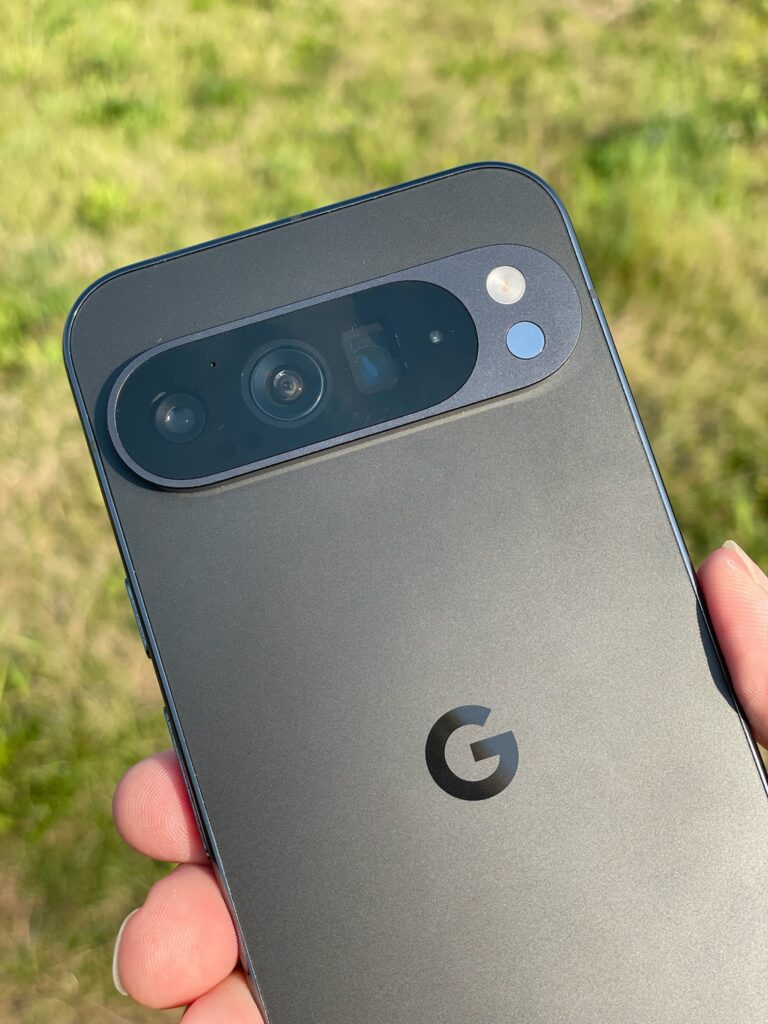
Google’s Pixel 9 Pro XL uses a newer version of its custom Tensor G4 chip (8-core, Mali-G715 MP7 GPU, 4 nm Armv9.2a), with major improvements in AI operation acceleration – the area that will play the most crucial role both now and in the future. That’s also why the RAM has been significantly increased to 16 GB (LPDDR5X), as the phone supports local AI that doesn’t require an internet connection. A small language and image AI model runs directly in the phone’s memory, handling tasks in text, voice, and even generating and editing images.
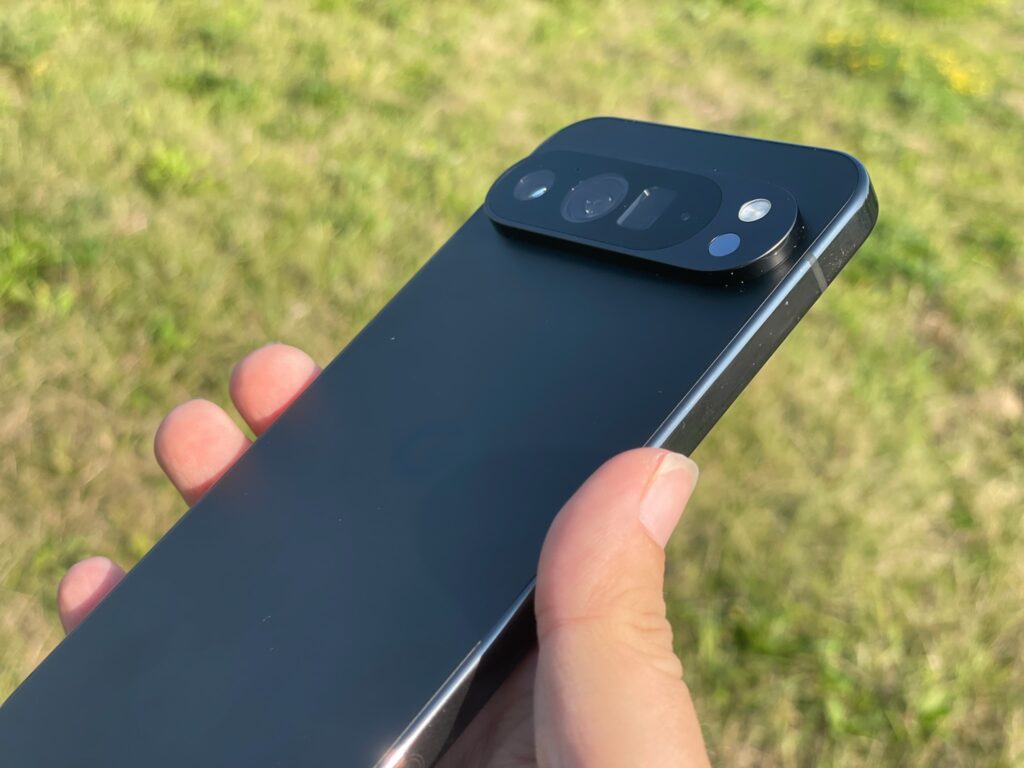
This is where we’ll focus, as it’s something you should seriously consider when buying a new phone now and in the future. If a phone is weak in AI performance, it will quickly become outdated in the coming years – and you definitely don’t want that.
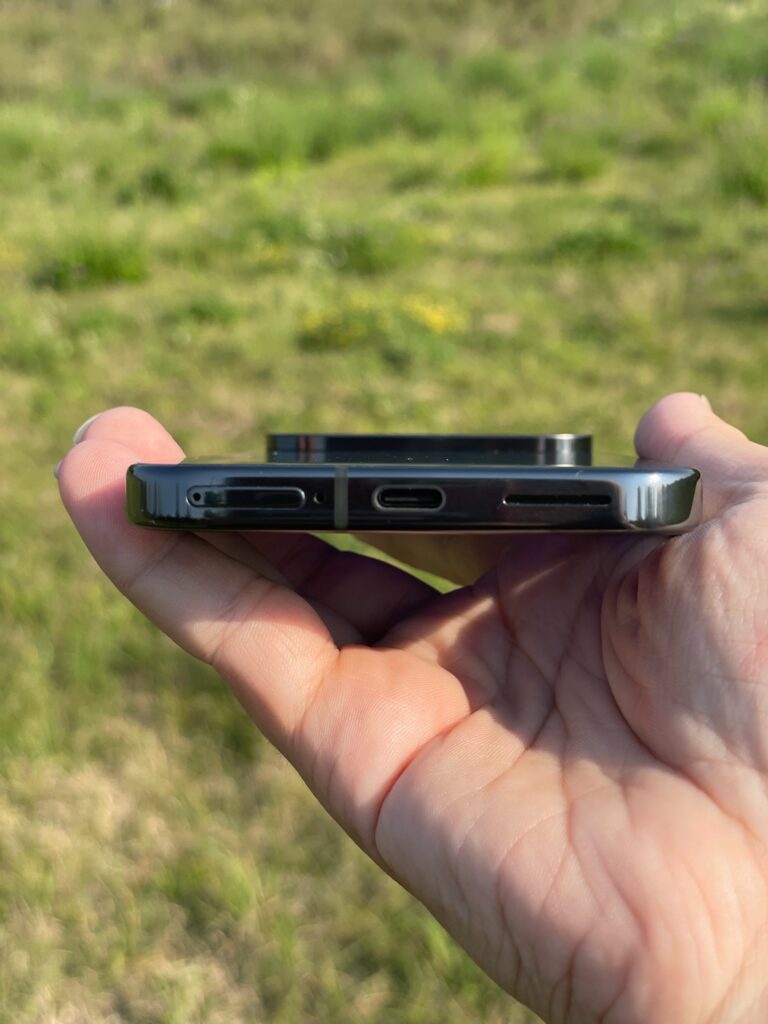
But let’s highlight a few other hardware specifications: Wi-Fi 7, Bluetooth 5.3, an improved modem for better mobile signal (Exynos 5400), and faster charging up to 37 W (23 W wirelessly via Qi). Pixels also come with a temperature sensor on the back, improved across generations, and include UWB (Ultra-Wideband) technology. The fingerprint sensor finally works great as well.
AI Performance – The Key Factor
AI performance is becoming a critical factor when choosing a phone. Thanks to Geekbench 6, which now includes a specialized AI performance test, we can compare the Tensor G4 chip’s AI power with other phones.
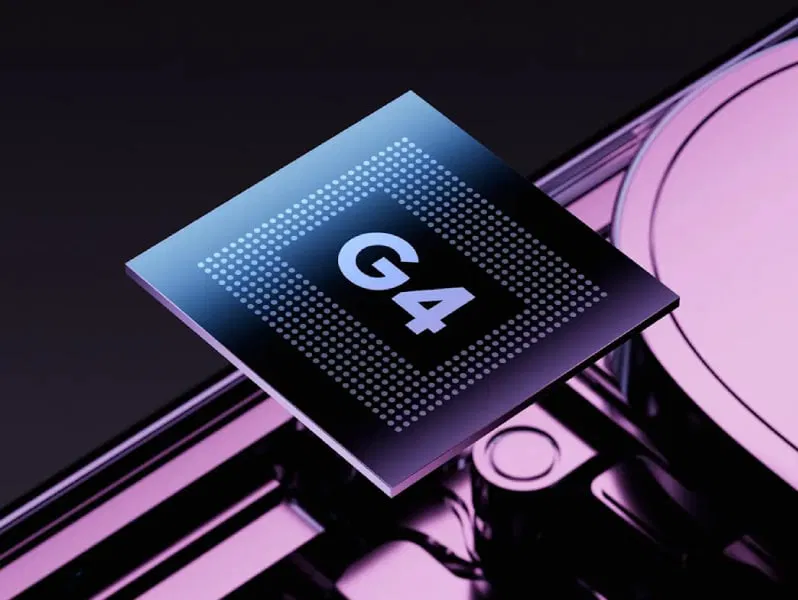
I’ve prepared two charts – the first shows a nice comparison of performance by operation, and you can see that Google is focusing on boosting the performance of quantized AI models with lower precision (these are mainly small models that run directly on devices), with about a 20% year-over-year increase. In contrast, Samsung is still handling everything rather averagely in this area, without clear optimization for where the market is heading with local models. Google, of course, understands this as they are the ones who initiated this new era thanks to transformers, the foundation of it all.
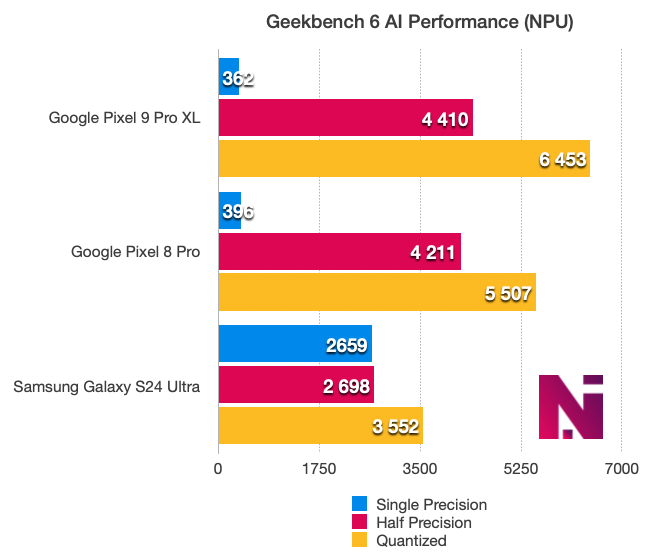
The second chart shows how these specialized mobile AI accelerators perform compared to top desktop hardware like the 16-core AMD Ryzen 9 7950X processor, the most powerful graphics card today – the Nvidia GeForce RTX 4090, and even the Apple MacBook M1, which includes a Neural Engine.
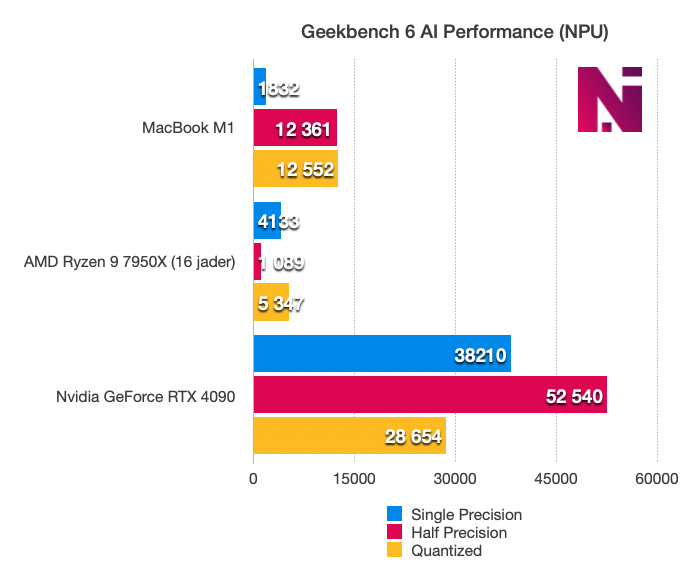
As you can see, Google Tensor’s AI acceleration has already surpassed the mentioned processor, achieving half the performance of Apple’s M1 chip and a quarter of the GeForce RTX 4090. Impressive, right? Of course, this only refers to quantized models. In higher precision areas, the difference is tenfold, or even a hundredfold compared to a full-blown graphics card. However, the chip’s optimization for a narrow field of AI calculations allows for much greater efficiency, delivering high performance at low power consumption. This is brilliantly demonstrated here.
What Can AI Do for Me?
Pixels come equipped with numerous features that utilize local AI acceleration. One typical example is image generation, which is relatively fast and customizable. However, like other public models, it suffers from heavy censorship, so you won’t be able to generate something like a black pope on the beach in a swimsuit. Only Grok on X can do this. Elon Musk just doesn’t like censorship of any kind.
Another major change is the integration of both a smaller local model and a large cloud-based Gemini (Advanced) model, which can be easily launched by holding the power button. However, due to prolonged development, Google seems somewhat schizophrenic – on one hand, you have the classic Google Assistant for simple commands, and on the other, you have the highly advanced Google Gemini (with a free year of Advanced subscription) that can handle everything from household and work tasks to philosophical discussions and even romantic AI relationships. After all, it understands you like no one else. Like when your wife sends you to Walmart for a loaf of bread, and you come back with a battery-powered Black & Decker drill because, of course, you can’t finish assembling that shelf in the kid’s room without it.

However, Gemini still doesn’t handle many tasks that Google Assistant does, and when it does, it often passes them off to Assistant. It’s expected that Google will eventually merge these and retire Google Assistant, sending it to the graveyard of killedbygoogle.com like so many other Google products and services. Gemini Live feature is great for seamless and fluent conversations, including interrupting AI during speech.
Thanks to the integration, you can have Gemini summarize what’s on your screen, including web pages, PDFs, or even photos. If you allow it to connect with your Google account, Gemini can also work with your data, such as emails, documents, and more. You can expect further expansion of these capabilities, which will greatly improve productivity and streamline many tasks.
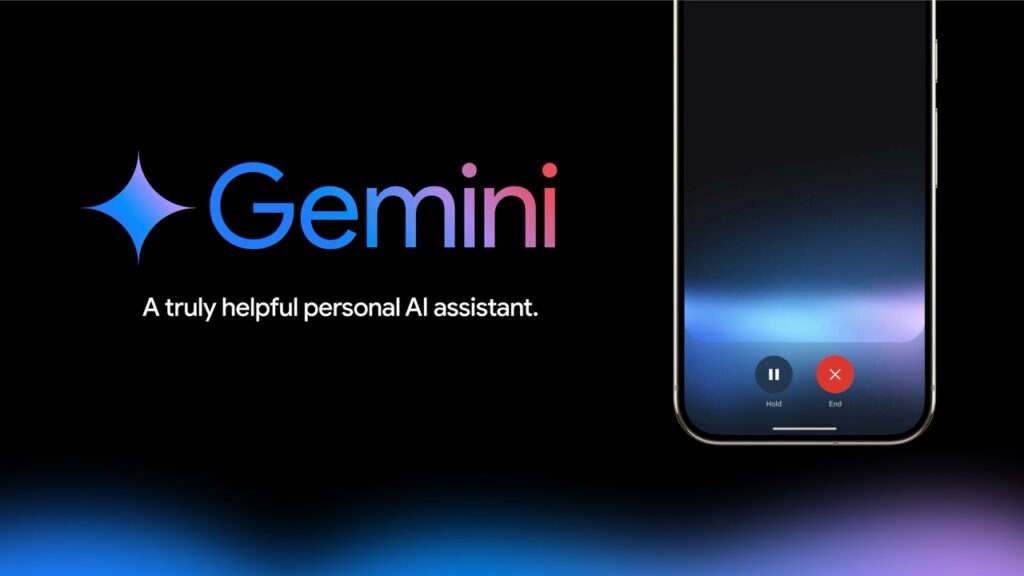
One interesting feature is group photos, where multiple people can all take a picture without needing a stranger to help – one person takes the photo, then switches places with someone else, and a new photo is taken from roughly the same angle. The images are then merged (though the person taking the second shot can’t stand in the exact same spot as the one who was replaced). This takes selfies to a new level, allowing you to photograph yourself in multiple copies.
The Magic Editor’s smart edits are also highly useful, including image generation that lets you change styles, entire scenes, or parts of the image, even moving objects or extending the photo beyond the captured edges.


We must slowly accept that photos created purely from photons captured on the camera sensor are becoming a thing of the past. Everything will not only be enhanced but also digitally remade more and more. Photos will become increasingly “unreal,” much like the lives of Instagram influencers.
Best Android Phone?
Even though I’m a longtime iPhone user, Pixel is one of the few Android phones that piques my interest and appeals to me because it’s essentially Google’s version of an iPhone. Clean design, excellent hardware, and integrated features and services directly from Google. I don’t like clutter – I prefer clean, fast systems. And Pixel delivers exactly that.
Google also promises updates for the next 7 years (later, primarily security updates), and we can look forward to Android 15 this year, which, like iOS, is now mostly refined in minor details.
The new Pixel 9 series goes on sale today. The base Pixel 9 (128 GB) costs $799, the Pixel 9 Pro (128 GB) is $999, and the larger Pixel 9 Pro XL is $1099. You can purchase them through the official Google store.
Complete Specifications
Google Pixel 9
• Display: 6.3” OLED, resolution 2424 × 1080 px (FHD+), 422 ppi, 60–120 Hz refresh rate, brightness up to 2700 nits (peak), protected by Corning Gorilla Glass Victus 2.
• Processor: Google Tensor G4 with Titan M2 security coprocessor.
• Memory: 12 GB RAM LPDDR5X.
• Storage: 128 GB or 256 GB UFS 3.1.
• Battery: 4700 mAh, supports 45 W fast charging and wireless charging.
• Rear Cameras:
• 50 MP, wide-angle (f/1.68, 82° field of view).
• 48 MP, ultra-wide-angle (f/1.7, 123° field of view).
• Super Res Zoom up to 8x.
• Video: 4K at 24/30/60 FPS, 1080p at 24/30/60 FPS.
• Front Camera: 10.5 MP, ultra-wide-angle (f/2.2, 95° field of view), 4K video at 30/60 FPS.
• Connectivity: Wi-Fi 7, Bluetooth 5.3, NFC, USB-C 3.2.
• Colors: Peony (pink), Wintergreen (light green), Porcelain (cream), Obsidian (dark gray).
• Durability: IP68 (water-resistant).
• Additional Features: Reverse wireless charging, stereo speakers, spatial audio, Gorilla Glass Victus 2 on the front and back.
Google Pixel 9 Pro
• Display: 6.3” LTPO OLED, resolution 2856 × 1280 px (FHD+), 495 ppi, adaptive refresh rate 1–120 Hz, protected by Corning Gorilla Glass Victus 2.
• Processor: Google Tensor G4 with Titan M2.
• Memory: 16 GB RAM LPDDR5X.
• Storage: 128 GB, 256 GB, 512 GB, or 1 TB UFS 3.1.
• Battery: 4700 mAh, supports 45 W fast charging, 21 W wireless charging.
• Rear Cameras:
• 50 MP, wide-angle (f/1.68, 82° field of view).
• 48 MP, ultra-wide-angle (f/1.7, 123° field of view).
• 48 MP, telephoto (f/2.8, 22° field of view, 5× optical zoom).
• Video: 8K at 30 FPS, 4K at 24/30/60 FPS, 1080p at 24/30/60 FPS.
• Front Camera: 42 MP, ultra-wide-angle (f/2.2, 103° field of view), 4K video at 30/60 FPS.
• Connectivity: Wi-Fi 7, Bluetooth 5.3, NFC, USB-C 3.2.
• Colors: Rose Quartz (light pink), Hazel (gray-green), Porcelain (cream), Obsidian (dark gray).
• Durability: IP68 (water-resistant), Ultra-Wideband (UWB) chip.
• Additional Features: Reverse wireless charging, stereo speakers, spatial audio, Gorilla Glass Victus 2 on the front and back.
Google Pixel 9 Pro XL
• Display: 6.8” LTPO OLED, resolution 2992 × 1344 px (QHD+), 486 ppi, adaptive refresh rate 1–120 Hz, protected by Corning Gorilla Glass Victus 2.
• Processor: Google Tensor G4 with Titan M2.
• Memory: 16 GB RAM LPDDR5X.
• Storage: 128 GB, 256 GB, 512 GB, or 1 TB UFS 3.1.
• Battery: 5060 mAh, supports 37 W fast charging and 23 W wireless charging.
• Rear Cameras:
• 50 MP, wide-angle (f/1.68, 82° field of view).
• 48 MP, ultra-wide-angle (f/1.7, 123° field of view).
• 48 MP, telephoto (f/2.8, 22° field of view, 5× optical zoom).
• Super Res Zoom up to 30x.
• Video: 8K at 30 FPS, 4K at 24/30/60 FPS, 1080p at 24/30/60 FPS.
• Front Camera: 42 MP, ultra-wide-angle (f/2.2, 103° field of view), 4K video at 30/60 FPS.
• Connectivity: Wi-Fi 7, Bluetooth 5.3, NFC, USB-C 3.2.
• Colors: Rose Quartz (light pink), Hazel (gray-green), Porcelain (cream), Obsidian (dark gray).
• Durability: IP68 (water-resistant), Ultra-Wideband (UWB) chip.
• Additional Features: Reverse wireless charging, stereo speakers, spatial audio, Gorilla Glass Victus 2 on the front and back.
All three models run on Android 14 and are available with dual SIM support (nanoSIM and eSIM).
